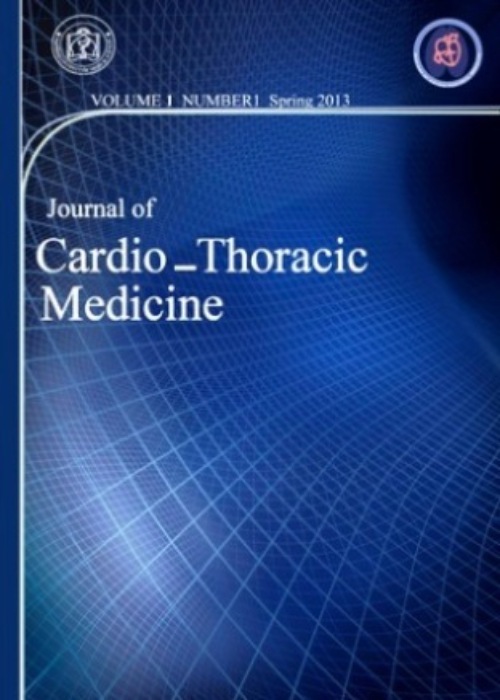Changes in Blood Gases and Hemodynamic Parameters in Patients Undergoing Lung Resection Surgery and Its Clinical Implications
Author(s):
Article Type:
Research/Original Article (دارای رتبه معتبر)
Abstract:
Introduction
Lung resection surgery is a challenge to thoracic surgeons. Outcome of surgery depends on patients’ tolerance to reduced lung volume and hemodynamic alterations. The present study aimed to investigate the changes in blood gases and hemodynamic parameters in patients undergoing lung resection surgery and the associated clinical implications.
Materials and methods
This study included 25 candidates for lung resection surgery. After thoracotomy, isolation of pulmonary artery (PA) and veins were performed as usual. Blood samples were taken from the PA and radial artery simultaneously before clamping, as well as 5 and 20 min after clamping the PA. The systemic as well as PA pressure was also measured. All patients were followed up, arterial blood gas and pulmonary function tests were performed 3-6 months after the surgery.
Results
Cough (56%) and hemoptysis (56%) were the commonest symptom. Most prevalent pathology was squamous cell carcinoma (56%). Lobectomy was the most common procedure performed on the patients. No change was observed in blood gases before and after the clamping of the PA. There was a significant increase in the mean PA pressure (P<0.001), while the mean arterial pressure showed no significant change (P=0.457). The pulmonary function tests showed a significant decrease in VC, forced vital capacity, and FEV1 at the postoperative follow-up. The patients with a pre-operative PCO2 of >45 mmHg had more postoperative complications than those with a PCO2 of ≤45 mmHg (P=0.047).
Conclusion
Given the lack of any significant changes in the PCO2 and oxygen saturation following the lung resection surgery, it seems that this parameter is not a limiting factor for deciding on operability in patients with lung lesions having an acceptable preoperative PO2 level. However, the patients with a PCO2 of >45 mmHg should be categorized as high-risk group since they have significantly higher postoperative complications/morbidity.Keywords:
Language:
English
Published:
Journal of Cardio -Thoracic Medicine, Volume:7 Issue: 1, Winter 2019
Pages:
406 to 412
magiran.com/p1943686
دانلود و مطالعه متن این مقاله با یکی از روشهای زیر امکان پذیر است:
اشتراک شخصی
با عضویت و پرداخت آنلاین حق اشتراک یکساله به مبلغ 1,390,000ريال میتوانید 70 عنوان مطلب دانلود کنید!
اشتراک سازمانی
به کتابخانه دانشگاه یا محل کار خود پیشنهاد کنید تا اشتراک سازمانی این پایگاه را برای دسترسی نامحدود همه کاربران به متن مطالب تهیه نمایند!
توجه!
- حق عضویت دریافتی صرف حمایت از نشریات عضو و نگهداری، تکمیل و توسعه مگیران میشود.
- پرداخت حق اشتراک و دانلود مقالات اجازه بازنشر آن در سایر رسانههای چاپی و دیجیتال را به کاربر نمیدهد.
دسترسی سراسری کاربران دانشگاه پیام نور!
اعضای هیئت علمی و دانشجویان دانشگاه پیام نور در سراسر کشور، در صورت ثبت نام با ایمیل دانشگاهی، تا پایان فروردین ماه 1403 به مقالات سایت دسترسی خواهند داشت!
In order to view content subscription is required
Personal subscription
Subscribe magiran.com for 70 € euros via PayPal and download 70 articles during a year.
Organization subscription
Please contact us to subscribe your university or library for unlimited access!


